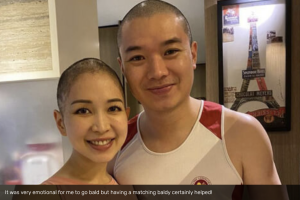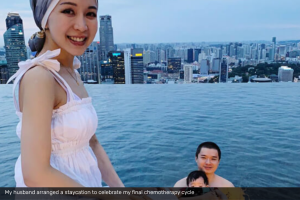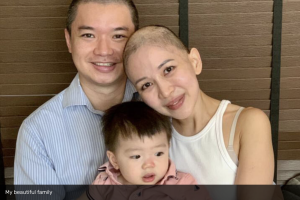“The general population, particularly younger women, believes breast cancer only affects older women. I used to be one of them until breast cancer struck me at the age of 38 years. In reality, breast cancer is increasingly affecting premenopausal women and those under 40, making it crucial to reach out to this group.” – Dr. Juliana
Young And Planning For A Second Baby
I am Dr Juliana Latif, the co-founder of Fusion Medical, which is a one-stop health screening practice located at Wheelock Place (Orchard).
I delivered my firstborn son at the age of 37 years old and put myself through 1 year of breastfeeding. The second month after stopping breastfeeding, my husband and I decided to continue with our family planning and scheduled our IVF procedure for our second child.
Little did I expect that my regular Breast Self Examination (BSE) done once a month would save my life. I detected a lump in my left breast when I was still breastfeeding my son, thinking that it was just a blocked milk duct. After all, I was below the age of 40. An ultrasound check on this lump just a week before the scheduled IVF procedure turned my world upside down.
Importance Of Breast Self-Examination (BSE)
Because of my own personal experience, Fusion Medical has introduced an education component on how to conduct your own BSE in most of our Health Screening packages.
When should one start?
The Singapore Cancer Society recommends that women as young as age 20 can start doing monthly breast self-examinations.
BSE should be timed on a monthly basis, 7-10 days from the start of your menstruation. If you have stopped menstruating, you can do your BSE on the same date each month.


*The images above were extracted from the Breast Cancer Foundation (Singapore). The full PDF file on breast self-examination can be found here.
What Happens When I Detect a Lump?
Additional checks will be performed upon discovery of a lump. These typically include breast ultrasound and /or mammography. You may wish to consider upgrading your mammography to a 3-dimensional one and to include an ultrasound scan if you have a history of dense breasts.
See more information here.
Does Finding A Lump Mean Breast Cancer?
Not always. While suspicious lumps often require a biopsy, most breast biopsies do not result in a cancer diagnosis. Even benign conditions may need follow-up and treatment.
If cancer is found, a detailed report will determine the next steps, identifying tumour type, growth rate, and treatment approach. Early detection is key. I initially ignored my lump, but I was fortunate to catch it in time for treatment. I still remember the heartbreak of kissing my one-year-old goodbye before a PET/CT scan to check if my cancer had spread. The two-hour wait felt like a lifetime—until I was told the cancer was localised.
My lump turned out to be invasive ductal carcinoma. But many breast conditions are non-cancerous, such as:
- Non-proliferative lesions: the most common being breast cysts, and the increase in breast cancer risk is very small
- Proliferative lesions without atypia (e.g., fibroadenoma, sclerosing adenosis): These lesions have excessive growth or cells in the ducts or lobules of the breast but do not look very abnormal. They include ductal hyperplasia (without atypia), fibroadenoma, and sclerosing adenosis.
- Proliferative lesions with atypia (e.g., atypical hyperplasia, intraductal papillomas): In these conditions, the cells in the ducts or lobules of the breast tissue grow excessively, and some of them no longer look normal. These types of lesions include ductal hyperplasia, atypical lobular hyperplasia, and intraductal papillomas. Breast cancer risk is about 4 to 5 times higher than normal.
While benign, these conditions can still increase long-term risk and require regular monitoring.
Breast Cancer Screening Options
-
Mammogram:
A mammogram is a low-dose X-ray picture of the breast. It can detect the presence of cancerous lumps even before they can be felt with the hand. Screening mammograms are routinely used to screen for breast cancer in women who have no specific symptoms. Diagnostic mammograms are done after suspicious results, abnormal physical findings, or screening mammograms. The diagnostic mammogram is used to determine if these suspicious or abnormal findings are indicative of breast cancer. Compared to screening mammograms, diagnostic mammograms are more detailed.
What is digital breast tomosynthesis?
Digital breast tomosynthesis (DBT) is 3D mammography that allows the breast to be examined 1 layer at a time instead of 1 flat image. DBT may be used together with 2D digital mammography as an additional tool in screening. To the patient, the DBT experience is very similar to a 2D mammography and the X-ray dose remains very low and under the guidelines of the FDA. To the radiologist who is the specialist reading the images, the DBT provides additional views of the breast to better analyse the breast tissue. -
Ultrasound:
A breast ultrasound is a scan that uses sound waves. The breast tissue deflects these waves, causing echoes, which provide a picture of the breast tissue. It has the ability to differentiate between a mass that is filled with liquid and a solid mass. Ultrasounds are helpful when a lump is felt, and the images can be used to further evaluate the abnormality. It also helps to measure the exact size and location of the lump and analyse the surrounding tissue.
-
MRI:
If initial diagnostic imaging is inconclusive, a breast MRI (magnetic resonance imaging) may be recommended. MRI uses magnetic energy and radio waves (not radiation) through the breast tissue to create a detailed picture, which allows for the distinction between normal and diseased tissue.
For more details, check out this article.
Diagnosis Is Just The Beginning
I cannot overstate how essential strong support is at the start of a cancer journey. For me, my greatest pillars were my husband and my mother. My treatment began during the early phase of the COVID-19 pandemic, and with travel restrictions in place, my overseas family couldn’t be by my side. Still, my mother braved the quarantine rules to come to Singapore, and each day she lovingly boiled chicken soup for me—truly the highlight of my day. My other daily joy was spending time with my husband and son. Despite how unwell I felt during chemotherapy, my husband made sure we went for a walk every single day. Being in nature helped keep my mind and body strong.
Returning to work was tough, as my self-confidence had taken a hit. But with the unwavering support of my loved ones and fellow survivors, I stayed positive and found my way back to a new version of normal.
As a primary care doctor, I’m grateful to use my own experience to help others, reminding my patients every day about the power of early detection and timely screening. My journey has humbled me, and I now count each new day as a true blessing.








Related Blogs
Visit Us
Start your skin health restoration journey with us today!
Fusion Medical @ Wheelock

501 Orchard Rd #04-11, Singapore 238880

Mon-Fri :8:30am – 5:30pm
Sat :8:30am – 1:00pm
Sun / PH :Closed
Fusion Medical @ Fusionopolis

1 Fusionopolis Link, #01-05 Nexus
@ One-North , Singapore 138542

Mon-Fri :8:30am – 5:30pm
Sat/Sun / PH :Closed











